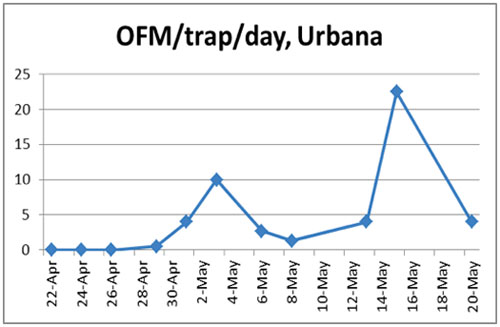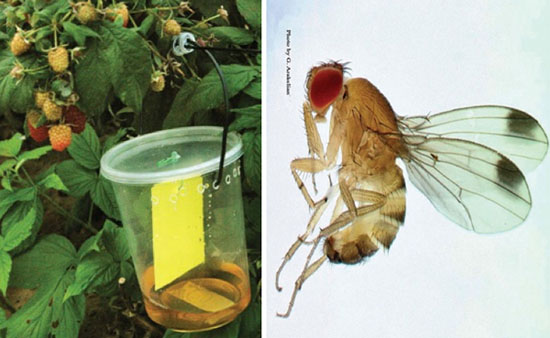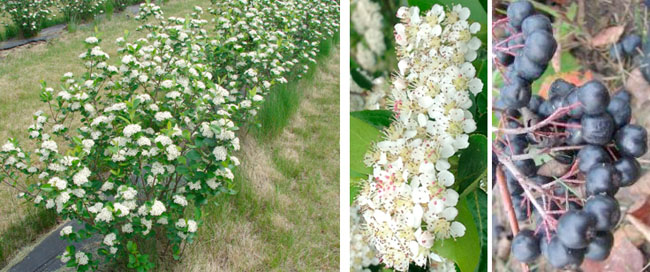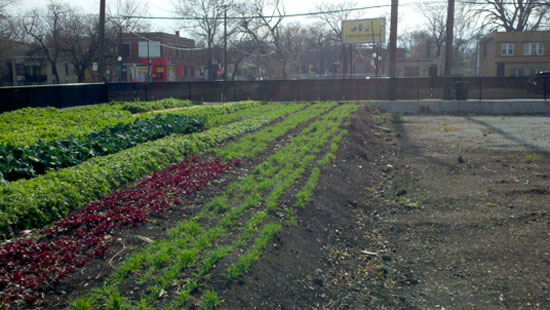"We are what we repeatedly do. Excellence, then, is not an act, but a habit." --Aristotle
Address any questions or comments regarding this newsletter to the individual authors listed after each article or to its editor, Rick Weinzierl, 217-333-6651, weinzier@illinois.edu. To receive e-mail notification of new postings of this newsletter, call or write the same number or address.
In This Issue:
Regional Observations (from Kyle Cecil in western Illinois)
Notes from Chris Doll (fruit progress, thinning, few insects, herbicide reapplications)
Fruit Production and Pest Management (updates on oriental fruit moth and codling moth, spotted wing Drosophila, thrips on strawberries)
Local Foods Issues (aronia berries; upcoming GAPs webinars; soil contaminants in urban farming)
Upcoming Programs
Check the Illinois SARE calendar for a full list of programs and links for registration.
http://illinoissare.org/ and http://illinoissare.org/calendar.php
- On-Farm Composting Workshop / Field Day; May 28 at Tempel Farms Organics, Old Mill Creek (Lake County); 8:30 am -2:00 pm. For more information, http://agriculture.illinoisstate.edu/downloads/WIU-TempelBrochure_May2013.pdf
- High Tunnel Building Workshop, May 29-30, 2013; 8:00 a.m. - 5:00 pm. Workforce Careers Center on the LLCC-Springfield campus, 5250 Shepherd Road, Springfield (Sangamon County). For more information or to register, contact Marnie Record at (217) 786-4993 or Marnie.Record@llcc.edu. Partial day participation is welcome.
- HerbFest, June 8, 2013; 8:30 a.m. - 3:00 p.m. Washington Park Botanical Garden, Springfield, IL. Registration is $40 for Illinois Herb Association members and $45 for non-members. Pre-registration is due by May 31 and includes lunch; on-site registration will take place from 8:30 to 9:00 the day of the event but does not guarantee lunch. See http://www.specialtygrowers.org/illinois-herb-association.html, or contact Charlene Blary, Illinois Herb Association, at 309-557-2107 or cblary@ilfb.org.
- Taking Your Farm to the Next Level: Equipment for Scaling Up Production, June 8, 2013; 1:45 - 4:30 p.m. PrairiErth Farm, 2047 County Road 2100 N, Atlanta (Logan County). Register at https://webs.extension.uiuc.edu/registration/?RegistrationID=7794
- Illinois Summer Horticulture Day, June 13, 2013 ... the morning program will be at Curtis Orchard in Champaign, IL, followed by an afternoon tour of the University of Illinois Fruit Research Farm in Urbana and Vegetable Crops Research Farm in Champaign. Details follow ...
 The Illinois State Horticultural Society
The Illinois State Horticultural Society
Horticulture Field Day
Thursday, June 13, 2013
Curtis Orchard and Pumpkin Patch (Champaign)
University of Illinois Fruit Research and Education Center (Urbana)
Hosts for this year are Paul and Joyce Curtis, Randy and Debbie Graham, and several family members.
Curtis Orchard is open July 20 through December 20 and offers many activities for the visitor. It includes a pick-your-own and pre-pick orchard with 25 acres of apples and peaches (some new plantings and varieties), a 20 acre pumpkin patch. The Flying Monkey Café is open daily for lunch, and the country store offers a variety of products including preserves, honey, apple butter salad dressings, popcorn, gift baskets, and unique kids' toys that are favorites. Visitors to the bakery will find donuts, fritters, pies and cobbler. Fun activities include: a petting zoo, giant slide, putt and play, a toddler area, live music, private parties and cider making, apple grading tours and presentations about honey bees.
The new 100 acre University of Illinois Fruit Research and Education Center was established in 2008 south of campus is used for teaching, research, outreach/extension education programs relating to fruits and vegetables. The perennial plants at the farm consist of 15 acres of apples, 3 acres of peaches, Asian pears, grapes, and small fruits. The research focus includes disease resistant cultivars, root stock compatibility, applied entomology and plant pathology. In addition, a genetic-source orchard is maintained for germplasm to be used for future genome mapping. Plans also include developing demonstration plots that will serve farmers and the general public on such topics as sustainable fruit production, nutritional components, integrated pest management, and impact of production on consumer health. The Sustainable Student Farm is also located at this site.
8:00 a.m. - 1:30 p.m. at Curtis Orchard | ||
8:00 A.M. | Registration | |
8:30 A.M. | Welcome | |
8:45-11:30 A.M. | Field Tours (Walking-Wagon Tours) | |
| Speakers during the field tours: | |
| Curtis Orchard: | Paul Curtis and Randy Graham |
| Univ of Illinois: | Horticulture: Mosbah Kushad |
|
| Entomology: Richard Weinzierl |
|
| Plant Pathology: Mohammad Babadoost |
|
| Weed Sciences: Elizabeth Wahle |
| Indoor Presentations | |
12:00 - 1:30 p.m. | Lunch and Lunch-Time Presentations | |
2:00 - 4:30 at the University of Illinois Fruit Research and Education Center | ||
| Field Tours (Walking-Wagon Tours) | |
| Apple and peach root stocks: | Mosbah Kushad |
| Disease resistant apple cultivars: | Schuyler Korban |
| Weed control in orchards: | John Masiunas |
| Insect pest management in orchards: | Rick Weinzierl |
| Disease management in orchards: | Mohammad Babadoost |
| High-tunnel vegetable production: | Zach Grant |
Sponsored by: Illinois State Horticultural Society, University of Illinois, Illinois Specialty Growers Association | ||
Regional Observations
In western Illinois, Field conditions improved significantly across the region recently until heavy rains on Monday night (May 20). For the most part, tomatoes destined for field production have gone in. As I mentioned in previous reports, the transplants had plenty of leg, but are doing well. At the same time (mostly under plastic) peppers have been planted. One grower I met with indicated that all of the first plantings of transplant crops are in and the next succession of plants is progressing well. Growers are marketing a variety of lettuces from leaf type to head type. Many have indicated to me that the trend is toward growing more of the head type as the labor required to harvest these crops is significantly reduced compared to loose leaf, and the consumers like the idea of having one small head per person per meal.
On the fruit side, peach leaf curl can be found almost anywhere in the region. Leaf symptoms appear about 2 weeks after leaves emerge from buds. The fungus grows between leaf cells and stimulates them to divide and grow larger than normal, causing swelling and distortion of the leaf. To prevent peach leaf curl, use resistant peach varieties where possible. For nonresistant varieties, treat the peach orchard with a fungicide every year in the fall after leaves have dropped or early in the spring when buds swell. Recommended fungicides are listed in the 2013 Midwest Tree Fruit Spray Guide. (This year's infections will not spread to additional leaves this season ... but keep in mind that control is necessary before the symptoms show up again next year.)
In area high tunnels we find tomatoes with two fruit clusters and a few cucumber varieties have had some harvested already. I see more high tunnels have been constructed this year over last. This is a positive sign toward the region being able to have more consistency in local food supplies throughout the year.
Kyle Cecil (309-342-5108; cecil@illinois.edu)
Notes from Chris Doll
Warm weather over several days and ample rainfall have allowed all fruit plants to move forward, and overall, crops look pretty good. Apples are now growing through the optimal size for thinning in orchards from here to the south, with only rescue attempts to reduce fruit numbers where needed. Fruit set was not as heavy as the bloom indicated on apples or peaches and varies from orchard to orchard and sometimes between varieties. Case in point: two reports of Encore peach where bloom appeared good but set ranged from light to very light. A Jersyglo block that had only medium flower numbers is reported to be light. In apples, most Goldens required thinning and only some Jonathans need help. Peaches have not yet advanced to club thinning age, but growers with the donut varieties might want to do hand thinning now as they are easily popped off, in contrast to very tight later on.
My small, isolated orchard has not trapped any codling moths or oriental fruit moths yet. Local grower reports are on the light side for these pests. A small number of rosy apple aphid infestations are present, as well as a few curculio-damaged fruits. Disease control appears good on all tree fruits as well.
Most new blocks of trees are in the ground and are showing growth. The use of clothespins or toothpicks to help with improving crotch angles is an easy task and usually worth the effort. Older blocks of trees, especially apples, may need to have limbs pulled down the horizontal level to induce bud and spur development and reduce the effects of apical dominance on growth and fruiting. One technician who was tying limbs down with rubber bands complained about the number of bands required for some larger branches. On some older trees where thin wires were used to pull or tie down shoots last year, the shoots had been girdled by the wires, so that is a factor to consider when choosing what to use to position the branches.
I have seen lots of good chemical weed control this spring, but depending on the material and application date, lots of it will not last as long as desired due to above-average rainfall amounts. When retreating with a contact herbicide at this time, is should be possible to add more of the original sterilant or a different ingredient. Plenty are listed in the weed control section of the 2013 Midwest Tree Fruit Spray Guide.
Chris Doll
Fruit Production and Pest Management
Updates on Codling Moth and Oriental Fruit Moth
Oriental fruit moth: I don't have reports of biofix dates for most other locations, but biofix for oriental fruit moth was April 18 near Batchtown in Calhoun County and April 29 at Urbana. Degree-day accumulations since biofix for each location are ...
Location |
Biofix Date |
Degree-Days base 45F, through May 22 |
Degree-Days base 45F, projected through May 29 |
Degree-Days base 45F, projected through June 6 |
|---|---|---|---|---|
Calhoun County |
April 18 |
526 |
669 |
824 |
Urbana |
April 29 |
472 |
600 |
742 |
Here's what the flight has looked like so far at Urbana. The low numbers for May 6-8 correspond with a few days of cold temperatures that did not favor moth flight.

The key spray period for first generation larval control is almost over here at Urbana, but the continued presence of moths in traps earlier this week means egg hatch and larval entry into shoots and fruit will continue for at least a few more days. Key sprays for second generation control should be timed to correspond with accumulations of 1,175 degree-days (base 45 F) and 1,475 degree-days after first generation biofix ... but always keep monitoring traps to observe flights in individual orchards. Effective insecticides for oriental fruit moth control include Altacor, Assail, Belt, Delegate, and Rimon; Entrust is effective in organic production.
Codling moth: Chris Doll (Edwardsville) and Tom Ringhausen (Calhoun County) have reported not catching enough moths to set a biofix for phenology models at their locations. At Urbana, traps caught lots of moths earlier this week following a biofix date of May 17. As of May 22, degree-days (base 50F) totaled 129, with a projection of 223 by May 29. See page 23 of the 2013 Midwest Tree Fruit Spray Guidefor recommend timing of application of various insecticides based on degree-day accumulations. Effective insecticides for codling moth control include Assail, Calypso, Altacor, Belt, Delegate, and Rimon. Entrust and codling moth virus products are available for organic growers. Again, see the Spray Guide for listings.
Mating disruption can be used successfully against oriental fruit moth, codling moth, and the peachtree borers ... it's a topic that I cover at length in winter programs. Contact me if you need information on this approach.
Spotted Wing Drosophila
Throughout the winter program season I encouraged everyone who grows strawberries, blueberries, brambles, and grapes to use traps to monitor for spotted wing Drosophila this season, beginning as each crop begins to develop color and ripen. Lots of useful information on this insect is summarized on a Michigan State University web site devoted to it ... http://www.ipm.msu.edu/invasive_species/spotted_wing_drosophila. A section on monitoring includes instructions on how to make and use traps to detect this insect's presence. This pest is present in Illinois and presents a severe threat production of blueberries and raspberries, especially (and to several other fruit crops)! If you did not pick up monitoring supplies from me this winter, now is the time check out the MSU web page and begin placing traps in your plantings.

Spotted wing Drosophila trap and adult male.
Eastern Flower Thrips
I've received a few reports of thrips infestations and damage in strawberries ... be sure to scout for these insects in strawberries from the time the first blossoms have opened until the last berries you intend to harvest are the diameter of a dime. The threshold is estimated at 2-10 thrips per blossom. See page 49 of the 2013 Midwest Small Fruit and Grape Spray Guide for a listing of effective insecticides.
Rick Weinzierl (217-244-2126; weinzier@illinois.edu)
Local Foods Issues
Notes on Aronia
Aronia berry (Prunus virginiana), also called black chokecherry, is a species of bird cherry native to North America. The aronia berry is known for its sharp and tart taste, but it is also desirable because it has high concentrations of antioxidants. The berries look like those of blueberries, except they are dull (not as glossy).
The largest acreage of aronia in Illinois (13 acres) is near Momence in Kankakee County. It has few insect, disease, or predation problems, and berries are used to make wines, juices, jams and jellies, frozen berries, teas, and other products.
We're preparing a field day for August and will keep you posted.

Aronia bushes, flowers, and berries.
James Theuri (815-933-8337; jtheu50@illinois.edu)
Good Agricultural Practices Webinar Series
A Good Agricultural Practices (GAPs) webinar series will be offered by University of Illinois Extension on Mondays, July 1, 8, 15, and 22, from 6 to 8 p.m., featuring a variety of topics on safe food production. Participants may attend from home via a computer with high-speed internet access and either a headset or speakers. Each registered participant will be sent webinar instructions, handouts, and a GAPs manual prior to the first webinar. There is a $15 fee per participant, and pre-registration along with pre-payment is required by June 25, 2013.
Topics for the webinar include:
- What are GAPs?
- Soil management/manure management
- Water quality and testing
- Record keeping
- Traceback
- Writing a food safety plan and being audited
Register online at http://web.extension.illinois.edu/gkw. For online registration, participants can choose to pay by credit card, for immediate confirmation, or by check, which will be a tentative registration until a check is received in office.
Registration can also be done by phone at 815-933-8337 with a credit card or in the office with cash, check, or credit card. For more information, contact Theuri at the Kankakee County Extension Office at 815-933-8337.
James Theuri (815-933-8337; jtheu50@illinois.edu)
Finding Soil Contaminant Thresholds for Urban Farming - a Moving Target
The number of people growing food in urban areas of Illinois has grown rapidly in recent years. Home gardening continues to be a popular pastime, but the number of community gardens, vacant lot gardens, and urban farms is growing rapidly. One of the biggest environmental challenges limiting further expansion of the urban food sector is heavy metal soil contamination. It is generally accepted (before any soil testing) that most urban soils are contaminated in some way. As a result, the safest approach in the establishment of an urban farm or garden is to grow in raised beds or some variation of a raised bed. For example, the "cap-and-fill" method for soil remediation is often used to create one gigantic raised bed on top of a vacant lot. Similar to a raised bed, soil and/or compost is imported from outside of the city and placed on top of a semi-permeable barrier to the existing soil (e.g., clay or crushed limestone; Figure 1). Raised beds and cap-and-fill systems are effective, but also expensive and potentially unsustainable. A less-expensive method for soil remediation is accomplished through compost application and incorporation in the existing soil to stabilize and sequester contaminants. However, this method is most appropriate when preliminary soil testing has been carried out to identify low to moderate levels of heavy metal contamination. Unfortunately, defining low, moderate, and high thresholds for heavy metal contamination in urban soils is difficult and feels like a moving target for many urban farmers.

Figure 1. Cap-and-fill method used at Growing Home's Honore St. Urban Farm in Chicago, IL.
Consistent thresholds are elusive because the threat of a given contaminant will vary depending on a variety of factors including soil texture, soil pH, soil organic matter, and soil fertility. For example, because lead (Pb3+) has a positive charge, it becomes less available in soil (and less threatening to humans) in the presence of organic matter because of its areas of negative charge. Thus, managing soil for increased organic matter by adding compost, using cover crops, reducing tillage, or using perennial crops can help to stabilize and sequester heavy metals like Pb in urban soils. The most common Pb soil contamination threshold used in the US is 400 ppm (established by the US EPA in the establishment of children's playgrounds), though "normal" soil concentrations outside of urban areas are closer to 20 ppm1. Average Pb concentration in Chicago soils is 395 ppm, but can be as high as 1,910 ppm1. The problem with interpreting soil test results and thresholds like these is that we are often not comparing apples to apples. For example, 400 ppm Pb in a sandy soil with 2% organic matter is more threatening (more mobile in the soil and available to plants and humans) than 400 ppm Pb in a silt loam soil with 6% organic matter.
Regardless of the level of contamination or threshold used, it is important for urban farmers and consumers to recognize that the primary pathway for exposure to heavy metal contamination is through the soil. Most plants have limited capacity for adsorbing heavy metals from the soil and moving them through the plant. It may sound silly, but the most practical recommendation for minimizing the risk of heavy metal exposure in urban garden soil is to avoid eating soil. While the majority of urban gardeners are not tempted to eat a spoonful of soil, most are "eating" smaller doses of soil when they inhale contaminated soil dust from the garden while rototilling or if they fail to thoroughly wash all soil from a carrot before eating. This type of indirect soil ingestion can be avoided by following the best management practices recently published by the US EPA2. Most of the EPA recommendations seem like common sense (wash and peel your produce, wear gloves in the garden, and grow in raised beds), but when followed can significantly minimize the threat of heavy metal exposure even in a contaminated soil.
If urban farmers are aware of potential or actual soil contamination (via soil testing) and take steps to minimize exposure to contaminants (follow best management practices), the benefits of urban agriculture will far exceed the environmental risks. For more information on managing soil contamination for urban agriculture, see the additional online references below3,4.
1. Kay, R. T., T. L. Arnold, W. F. Cannon, D. Graham, E. Morton, and R. Bienert. 2003. Concentrations of Polynuclear Aromatic Hydrocarbons and Inorganic Constituents in Ambient Surface Soils, Chicago, Illinois: 2001-02. Available online at <http://il.water.usgs.gov/pubs/wrir03_4105.pdf> Accessed May 14, 2013.
2. US EPA. 2011. Brownfields and Urban Agriculture: Interim Guidelines for Safe Gardening Practices. Available online at <http://www.epa.gov/swerosps/bf/urbanag/pdf/bf_urban_ag.pdf> Accessed May 14, 2013.
3. Turner, A. H. 2009. Urban Agriculture and Soil Contamination: An Introduction to Urban Gardening. Available online at <http://louisville.edu/cepm/publications/practice-guides-1/PG25 - Urban Agriculture - Soil Contamination.pdf/at_download/file> Accessed May 14, 2013.
4. Heinegg, A., P. Maragos, E. Mason, J. Rabinowicz, G. Straccini, and H. Walsh. 2002. Soil Contamination and Urban Agriculture: A practical guide to soil contamination issues for individuals and groups. Available online at <http://www.ruaf.org/sites/default/files/guide on soil contamination.pdf> Accessed May 14, 2013.
Sam Wortman (217-300-0232; swortman@illinois.edu)
Less seriously ...
Patrick walks into a bar in Dublin, orders three pints of Guinness and sits in the corner of the room, drinking a sip out of each pint in turn. When he had finished all three, he went back to the bar and ordered three more. The barman says, "You know a pint goes flat soon after I pull it . Your pints would taste better if you bought one at a time."
Patrick replies, "Well now, I have two brodders, one is in America and de odder in Australia and here I am in Dublin. When we all left home, we promised dat we'd drink dis way to remember de days we all drank togedder."
The barman admits that this is a nice custom and says no more.
Patrick becomes a regular customer and always drinks the same way ... ordering three pints and drinking a sip out of each in turn, until they are finished. One day, he comes in and orders just two pints. All the other regulars in the bar notice and fall silent. When he goes back to the bar for the second round, the barman says, "I don't want to intrude on your grief but I wanted to offer my condolences on your great loss." Patrick looks confused for a moment, then the penny drops and he starts to laugh, "Oh no," he says, "Bejesus, everyone is fine! Tis me ... I've quit drinking!"
University of Illinois Extension Specialists in Fruit and Vegetable Production & Pest Management
Extension Educators – Local Food Systems and Small Farms |
||
Bronwyn Aly, Gallatin, Hamilton, Hardin, Pope, Saline, and White counties |
618-382-2662 |
|
Katie Bell, Franklin, Jackson, Perry, Randolph, & Williamson counties |
618-687-1727 |
|
Sarah Farley, Lake & McHenry counties |
847-223-8627 |
|
Nick Frillman, Woodford, Livingston, & McLean counties |
309-663-8306 |
|
Laurie George, Bond, Clinton, Jefferson, Marion, & Washington counties |
618-548-1446 |
|
Zachary Grant, Cook County | 708-679-6889 | |
Doug Gucker, DeWitt, Macon, and Piatt counties |
217-877-6042 |
|
Erin Harper, Champaign, Ford, Iroquois, and Vermillion counties |
217-333-7672 |
|
Grace Margherio, Jackie Joyner-Kersee Center, St. Clair County |
217-244-3547 |
|
Grant McCarty, Jo Daviess, Stephenson, and Winnebago counties |
815-235-4125 |
|
Katie Parker, Adams, Brown, Hancock, Pike and Schuyler counties |
217-223-8380 |
|
Kathryn Pereira, Cook County |
773-233-2900 |
|
James Theuri, Grundy, Kankakee, and Will counties |
815-933-8337 |
|
Extension Educators – Horticulture |
||
Chris Enroth, Henderson, Knox, McDonough, and Warren counties |
309-837-3939 |
|
Richard Hentschel, DuPage, Kane, and Kendall counties |
630-584-6166 |
|
Andrew Holsinger, Christian, Jersey, Macoupin, & Montgomery counties |
217-532-3941 |
|
Extension Educators - Commercial Agriculture |
||
Elizabeth Wahle, Fruit & Vegetable Production |
618-344-4230 |
|
Nathan Johanning, Madison, Monroe & St. Clair counties |
618-939-3434 |
|
Campus-based Extension Specialists |
||
Kacie Athey, Entomology |
217-244-9916 |
|
Mohammad Babadoost, Plant Pathology |
217-333-1523 |
|